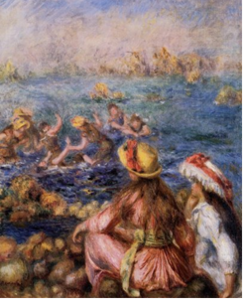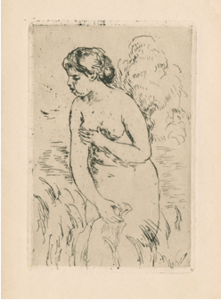IMPRESSIONISTIC GRAPHIC ART OF PIERRE-AUGUSTE RENOIR IN LITHUANIA 0
In brief: Everybody is acquainted with paintings of the French impressionist Pierre-Auguste Renoir; still, graphic art of the painter is not so well known; these works are presented to people more seldom, and the majority have not heard about graphic works of Renoir at all most probably, even though several prints of this impressionist are stored at the National M.K.Čiurlionis Art Museum, Collection of Foreign Graphic Art. Therefore, the author has decided to present these works to the reader more thoroughly.
Impressionism was born in France in 1874, when a group of young Parisian artists rallied and organised an exhibition of their works after they were not accepted to official galleries. Renoir made his first impressionistic steps along with Monet – they painted landscapes but Renoir was interested in picturing a human figure more.
Pierre-Auguste Renoir made his first graphic prints in about 1890, but almost three fourths of them were created after the year 1900 already. Thus, at the crossing of the centuries he was a famous and well known artist in his fifties. The artist became interested in graphic art due to practical reasons – colleagues and publishers kept asking whether he wanted his works reproduced. Tired of these questions the artist started creating equivalents of his paintings by various graphic art techniques. Renoir created the biggest part of his 60 prints during the latter 14 years of his life: 25 etchings and 35 lithographs.
The biggest part of the artist’s graphic prints were published in catalogues at the initiative of Ambroise Vollard and Teodor Duret. A big part of Renoir’s etchings and drypoint works were published in books.
One of the first graphic works is the etching “At Berneval Beach” created in 1892. Two figures of girls sitting at the beach are pictured in the small print. The girls are known: these are Julie Manet, the daughter of the painter Berthe Morisot and Eugene Manet, with her cousin Paulette Gobillard.
The abstract landscape of the etching pulsates and vibrates but the biggest attention is paid to the young girls sitting with backs to the painter in the work.
This print was created according to the painting “Swimmers” painted in about 1892. Both works reflect moments from the painter’s life – his holidays in Normandy, where he spent much time with the family of his friend Edouard Manet.
Women are very important in Renoir’s works. He chose relatives, friends, lovers as his models; he even dressed his sons as girls and painted them. Nudes of women prevail in the later creative period of the artist. This period is illustrated by the etching “Swimmer in Water to the Knees” well created in about 1910.
A young woman standing in water surrounded by swinging reeds is pictured in the print. Her movements remind of the painting of Sandro Botticelli “Birth of Venus”, in which the born goddess of beauty also tries to cover her nakedness. The influence of classicism is strongly felt in this work of Renoir. Renoir pictures a graceful woman of feminine forms, she is timid and trying to hide from the spectator’s eyes. This work reminds of the artist’s painting “Swimmer (After Swimming)” painted in 1888. It is possible to suppose that the artist’s wife Aline Charigot, who gave birth to three sons of Renoir, is pictured in these works.
Even though influenced by classical painting and academic rules of picturing a human body, the artist creates in an impressionistic manner – the nature surrounding the woman vibrates, light waving of water may be felt, it seems that the first impression is captured in the graphic print.
Pierre-Auguste Renoir, like other impressionists, created in plein-airs, pictured melting forms without strong contours, refused local colours. He succeeded to render changing nature even in graphic works. The artist stood out from the big crowd of impressionists by dedicating his works to a human being. Renoir had the skill to notice and admire female beauty, playfulness and to emphasise the charm of daily life.




